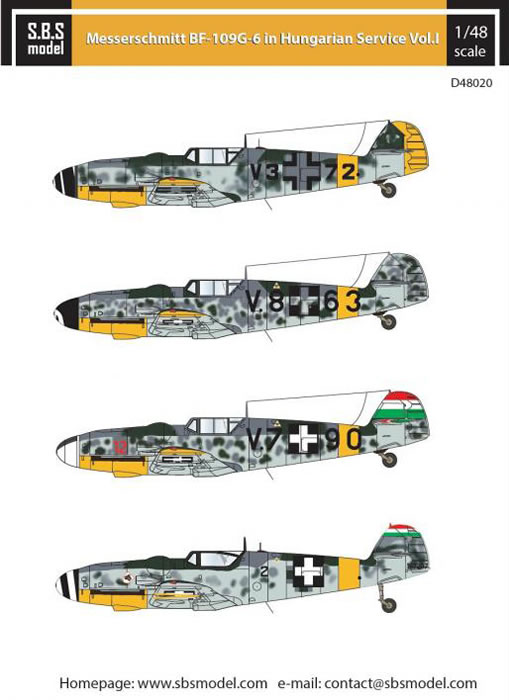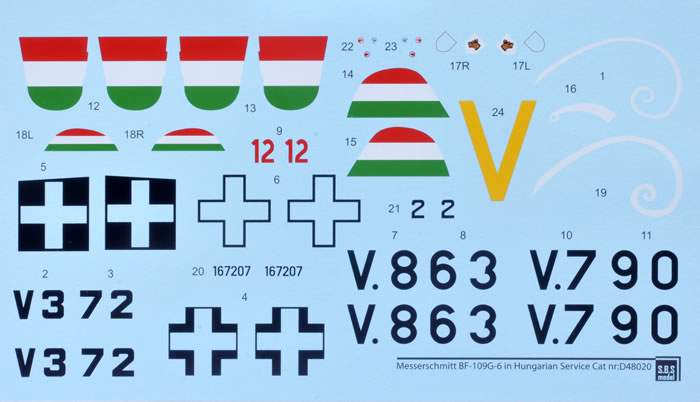Messerschmitt Bf 109 G-6 in Hungarian Service Vol.1

SBS Model, 1/48 scale
S u m m a r y |
| Item No. |
SBS Model Item No. D48020 - Messerschmitt Bf 109 G-6 in Hungarian Service Vol.1 |
| Contents and Media: |
Markings for four aircraft on two decal sheets; full colour instructions. |
| Scale |
1/48 |
| Price: |
Euro 10
plus shipping available online from SBS Model
(also available in 1/72 scale for Euro 8) |
| Review Type: |
FirstLook |
| Advantages: |
Interesting subjects; decas in perfect register; four-view diagrams in colour. |
| Disadvantages: |
|
| Recommendation: |
These decals offer some interesting alternatives to German markings for your 1/48 scale Messerschmitt Bf 109 G-6 models. |
Reviewed
by Brett Green

HyperScale is proudly supported by Squadron.com
In October 1942, the Luftwaffe agreed to partially re-arm Royal Hungarian Air Force fighter units with the Bf 109.
Subordinated to the German Jagdgeschwader 52 on the Eastern Front, the first Hungarian fighter unit to convert to the Bf 109 F-4 was the RHAF's 1./1. vadászszázad (fighter squadron).
Several other fighter units converted to the 109 F and later G models during the course of 1943 and were heavily engaged in combat on the Eastern Front. During April and May 1944, the new Bf 109 Gs were concentrated into the 101. Honi Légvédelmi Vadászrepülő Osztály (101st Home Air Defence Fighter Wing). The Hungarian Messerschmitt factory at Győr produced many of these under licence.
The unit, commanded by the experienced Eastern Front veteran Major Heppes Aladár, was also known as the Red Pumas after its insignia.
During 'The American Season', between May and August 1944, the 101. had claimed 15 P-51s, 33 P-38s and 56 four-engine bombers, but Hungarian losses were high too: 18 fighter pilots lost their lives. The heaviest losses occurred on 7 August 1944, when 18 Bf 109s from 101 Fighter Group, escorting Luftwaffe Bf 109 G-6s, armed with additional cannons in underwing gondolas, took off to intercept 357 four-engined American bombers, escorted by 117 fighters. The Messerschmitts were intercepted by the escorting P-51 Mustangs that shot down eight Hungarians and at least nine Germans Bf 109s, losing just two of their number. Among the killed "Pumas" was Lt László Molnár Lukács, the top scoring Hungarian pilot to date, with 25 kills (including seven American aircraft).
By November 1944 the 101. was re-organized into a fighter regiment, and was re-equipped with the latest Messerschmitt Bf 109 G-10 and G-14 types. At the end of December the pilots received new Bf 109s at Wiener-Neustadt and were subsequently transferred to the Kenyeri airfield.
Early in February 101 Fighter Wing received 26 brand new Bf 109 G-10/U4s with the instructions that their engines had to be changed after 30–40 operating hours. However, combat missions against the 15th USAAF came to an end, and the 101st's main adversary in the air became the Red Air Force. The Hungarian pilots were numerically far inferior to the Soviets but they nevertheless attacked. On 9 March eight Bf 109Gs from 101/3 fighter squadron intercepted a formation of 25 Soviet Douglas Boston bombers escorted by 16 Yak-9s and shot down three. Two weeks later eight "Red Pumas" attacked 26 Soviet aircraft south of Lake Balaton and shot down five without a single loss.*
* Historical summary adapted from Wikipedia
S.B.S. Model is a Hungarian company that produces resin kits, multimedia accessories and decals.
Amongst their latest batch of releases is a decal set, Messerschmitt Bf 109 G-6 in Hungarian Service Vol.1.
This set covers four Hungarian Bf 109 G-6s that saw service during 1944:
-
V3+72 operating out of Poland in May 1944. This aircraft features the low-visibility black markings, plus yellow Eastern Front theatre markings - yellow lower cowl, fuselage band, lower wing tips and rudder. The upper wing markings are non-standard, and the spinner has a thin white spiral.
-
V.8+63 near Zalaszentgrot, August 1944. Low-visibility black markings except for lower wng crosses, plus yellow Eastern Front theatre markings - yellow lower cowl, fuselage band, lower wing tips and rudder. The spinner has a short white spiral.
-
Black 2 operating out of Vadaszszazad in Autumn 1944. This aircraft features high visibility black and white markings, plus yellow Eastern Front theatre markings - yellow lower cowl, fuselage band, lower wing tips and rudder. Hungarian national colours are painted on the top of the fin/rudder. A southern theatre yellow chevron is also painted on the bottom of the starboard wing. The spinner has a standard white spiral.
-
V.7+90 operating out of Vadaszszazad in March 1944. This aircraft features high visibility black and white markings, plus yellow Eastern Front theatre markings - yellow lower cowl, fuselage band, lower wing tips and rudder. Hungarian national colours are painted horizontally across the fin/rudder and the outboard tail planes (upp and lower. The spinner is thirded black and white.
All four subjects are finished in the standard mid-war Luftwaffe colours of RLM 74 Grey Green, RLM 75 Grey Violet and RLM 76 Light Blue.
Instructions offer four views in full colour plus notes on the camouflage and markings.

The decals are provided on two sheets. One has national markings, while the second larger sheet includes the rest (plus some non-standard national markings).

There is no mention of who has printed the decals, but they look similar to Eduard's. Colours are vivid and registration is perfect.
These decals offer some interesting alternatives to German markings for your 1/48 scale Messerschmitt Bf 109 G-6 models.
Thanks to SBS Model for the samples
Review Text Copyright © 2017 by Brett Green
Page Created 25 September, 2017
Last updated
25 September, 2017
Back to HyperScale Main Page
Back to Reviews Page
|
Home
| What's New |
Features |
Gallery |
Reviews |
Reference |
Forum |
Search